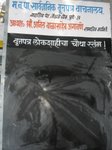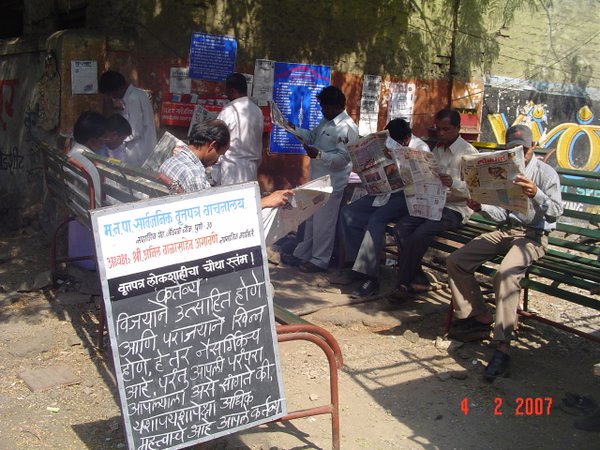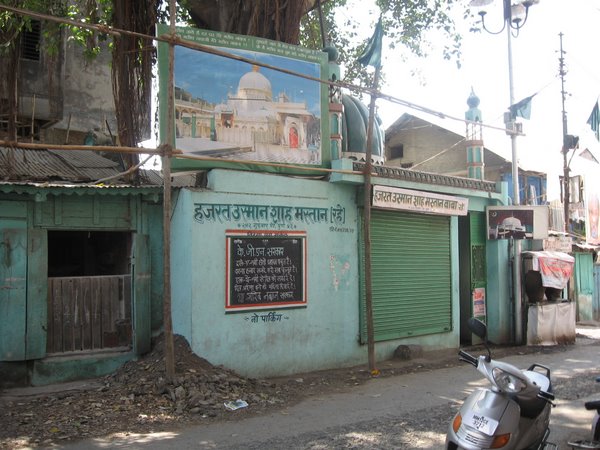This study revolves around a particular ‘genre’ of public space that is a result of a popular practice among the various collectives in Pune city. The practice is that of putting up ‘vartaphalak’ or notice boards which serve as visual markers of the collective that exists in the precincts of that notice board. In many cases, these notice boards are not ‘stand alone’ markers, but are a part of an entire set of accoutrements, which the collective uses to declare its presence in that space. Most commonly, the additional accoutrements are in the form of a small covered space, like a bus stop, which serves as a place where people can sit and read daily newspapers provided in a rack. Or there could be a couple of benches, adjacent to the notice board, again meant for sitting. Sometimes there is an additional provision of space where drinking water is made available to the pedestrians during summers in huge earthen pots (pan poi). It is also not uncommon to find a small temple in this same space.
These notice boards are put up by collectives which are constituted by political as well as non-political organizations in the city, including local, branches of all the political parties, collectives like Ganesh mandals, ‘Yuva mitra mandals’, residential collectives, auto rickshaw drivers’ unions etc. The content of the notice boards ranges from local, collective-specific concerns to commentary on current regional or national issues. These spaces become the centre point around which many local celebrations like ‘Satyanarayan Puja’, Ganesh festival, Independence Day and so on are organized.
The remarkable feature of these spaces is that they have extremely rich visual content. Firstly, there are the various comments, notices, announcements written on the boards for local community members to read. Examples of this include notice offering condolences to the family of the deceased, who was the local resident, announcement of a blood donation camp organized in the locality, congratulatory message on the occasion of Independence Day, comments on some current issue, like the financial budget or Samjhauta blasts and so on.
At the same time, the various symbols and imagery that is inscribed in and around these spaces, though ubiquitous, are significant visual markers of identity, local, regional or even national. These range from the symbols of political parties, displayed prominently on the boards or the newspaper stands, colour of the newspaper stand itself, photographs or pictures of prominent national leaders/ icons like Gandhi, Ambedkar, Jyotiba Phule, Shivaji etc. Similarly, the content of the boards itself also is a clear indicator of the political/ ideological alignments of the collective that the boards represent. These identity signifiers are particularly underlined during a local celebration, which centers around that space. In many places occasions like Gudi Padwaa, Ambedkar Jayanti, and Independence Day are celebrated with great pomp, with the enthusiastic participation of the local community members in the organization of the events.
These hubs thus serve to weave in multiple levels of concerns for the local community members. By reflecting interests and happenings within the local community, it serves to consolidate the local communal fabric. At the same time, articulation of the regional or national identity makes it possible to extend and strengthen this sense of solidarity to include the larger regional or national ‘community’. Identity building and consolidation of the same is a major area of study in the context of these spaces.
As already mentioned, several of the notice board spaces are sponsored by local branches of political parties. Notably, all of the newspaper racks are also financed by various corporators’ ward development funds. The political link is obvious in many places, while it is obscured, though present in several others. Based upon the assumption that these spaces do play a considerable role in strengthening community identities through activities couched in religious or social service sphere, they also become a convenient strategy for political mobilization and political activity in the local areas. In this light, what kind of population are these spaces aimed at, would be another point of inquiry. Who makes use of these spaces, who takes initiative in maintenance and organization of the spaces and celebrations around it, what is the class, gender, and age profile of people who access these spaces; these are some of the questions that the study would seek to explore.
Another significant aspect of the ‘varta phalak’ culture is the spatial distribution of these hubs in the city. One can safely say that the network of the hubs is definitely denser in the older parts (peths) of the city than those which have been recently developed. This is not a coincidence, given the fact that it is largely the older parts of the city which participate in the political identity formation of the city. A crude caste-based division is evident across the older peths as some areas have a predominantly lower caste/ artisan caste populations as opposed to some others, which are inhabited by upper caste populace, notably Brahmins. The question is whether there is a difference in the rhetoric used in the notice-boards here, based upon the differential caste population in the respective peths. A primary level hypothesis is that the rhetoric used in the areas inhabited by lower/ artisan castes is directed more towards strengthening local level community and regional identity, while the rhetoric used in upper caste areas is at a different level, appealing to identity linked to cultural heritage and nationalism.
Given the nature of these spaces, the study would be inadequate without a gender analysis of the same. Analyzing the users as well as the composition of these spaces from a gender point of view would be interesting, especially since these spaces constitute sites for articulation and consolidation of identities as well as political mobilization. I plan to construct a photo-essay comprising of maximum 35 photographs, covering the above issues. The outcome of the study also includes a review paper exploring these issues in detail; it would be based upon the fieldwork done during this study as well as a review of literature in the area of public spaces, visual culture and identity formation.
Work completed till now
I’ve managed to finalize my ‘field areas’ so to say, as well the specific vartaphalak in those locations. I would be including a maximum of 15 such vartaphalaks, spanning the four areas of Sadashiv Peth, Narayan Peth, Guruwar Peth and Ghorpade Peth. The first two areas are almost exclusively Brahmin populated areas, while the latter two display a high proportion of lower caste communities and Muslim population. The vartaphalaks belong to a variety of collectives, including political parties, local yuva mandals or ‘friend circles’ and religious trusts. Majority of them are Hindu collectives, though there are two Muslim collectives from Guruwar and Ghorpade Peth.
The exercise of building rapport with people who are associated with these spaces was a huge learning, to say the least. Let me locate myself as a researcher here: I’m a middle class Maharashtrian Brahmin woman, who has always inhabited the ‘progressive’ ‘modern’ part of the city. Sadashiv Peth and Narayan Peth are the kind of areas with which I’m familiar; but in my growing years, areas like Guruwar and Ghorpade Peth, people there, were definitely the ‘other’: lower middle class, non-Brahmin communities. This study gives me the opportunity to deconstruct my own notions of class and community as I interact with this very group of people to understand what these spaces mean to them. Till now I have gotten an enthusiastic response to my venture, with members of local collectives promising earnest co-operation.
My brief interaction with people who actually write the content on the varaphalak led me to concretize my intention to profile these persons, their backgrounds and their political aspirations. But it’s hardly a homogenous group and developing some kind of an interview guide requires much thinking through and some more interaction, I think.
Brevity was never a skill with me, as is obvious now. But any comments, questions and feedback on the study is most welcome!
These notice boards are put up by collectives which are constituted by political as well as non-political organizations in the city, including local, branches of all the political parties, collectives like Ganesh mandals, ‘Yuva mitra mandals’, residential collectives, auto rickshaw drivers’ unions etc. The content of the notice boards ranges from local, collective-specific concerns to commentary on current regional or national issues. These spaces become the centre point around which many local celebrations like ‘Satyanarayan Puja’, Ganesh festival, Independence Day and so on are organized.
The remarkable feature of these spaces is that they have extremely rich visual content. Firstly, there are the various comments, notices, announcements written on the boards for local community members to read. Examples of this include notice offering condolences to the family of the deceased, who was the local resident, announcement of a blood donation camp organized in the locality, congratulatory message on the occasion of Independence Day, comments on some current issue, like the financial budget or Samjhauta blasts and so on.
At the same time, the various symbols and imagery that is inscribed in and around these spaces, though ubiquitous, are significant visual markers of identity, local, regional or even national. These range from the symbols of political parties, displayed prominently on the boards or the newspaper stands, colour of the newspaper stand itself, photographs or pictures of prominent national leaders/ icons like Gandhi, Ambedkar, Jyotiba Phule, Shivaji etc. Similarly, the content of the boards itself also is a clear indicator of the political/ ideological alignments of the collective that the boards represent. These identity signifiers are particularly underlined during a local celebration, which centers around that space. In many places occasions like Gudi Padwaa, Ambedkar Jayanti, and Independence Day are celebrated with great pomp, with the enthusiastic participation of the local community members in the organization of the events.
These hubs thus serve to weave in multiple levels of concerns for the local community members. By reflecting interests and happenings within the local community, it serves to consolidate the local communal fabric. At the same time, articulation of the regional or national identity makes it possible to extend and strengthen this sense of solidarity to include the larger regional or national ‘community’. Identity building and consolidation of the same is a major area of study in the context of these spaces.
As already mentioned, several of the notice board spaces are sponsored by local branches of political parties. Notably, all of the newspaper racks are also financed by various corporators’ ward development funds. The political link is obvious in many places, while it is obscured, though present in several others. Based upon the assumption that these spaces do play a considerable role in strengthening community identities through activities couched in religious or social service sphere, they also become a convenient strategy for political mobilization and political activity in the local areas. In this light, what kind of population are these spaces aimed at, would be another point of inquiry. Who makes use of these spaces, who takes initiative in maintenance and organization of the spaces and celebrations around it, what is the class, gender, and age profile of people who access these spaces; these are some of the questions that the study would seek to explore.
Another significant aspect of the ‘varta phalak’ culture is the spatial distribution of these hubs in the city. One can safely say that the network of the hubs is definitely denser in the older parts (peths) of the city than those which have been recently developed. This is not a coincidence, given the fact that it is largely the older parts of the city which participate in the political identity formation of the city. A crude caste-based division is evident across the older peths as some areas have a predominantly lower caste/ artisan caste populations as opposed to some others, which are inhabited by upper caste populace, notably Brahmins. The question is whether there is a difference in the rhetoric used in the notice-boards here, based upon the differential caste population in the respective peths. A primary level hypothesis is that the rhetoric used in the areas inhabited by lower/ artisan castes is directed more towards strengthening local level community and regional identity, while the rhetoric used in upper caste areas is at a different level, appealing to identity linked to cultural heritage and nationalism.
Given the nature of these spaces, the study would be inadequate without a gender analysis of the same. Analyzing the users as well as the composition of these spaces from a gender point of view would be interesting, especially since these spaces constitute sites for articulation and consolidation of identities as well as political mobilization. I plan to construct a photo-essay comprising of maximum 35 photographs, covering the above issues. The outcome of the study also includes a review paper exploring these issues in detail; it would be based upon the fieldwork done during this study as well as a review of literature in the area of public spaces, visual culture and identity formation.
Work completed till now
I’ve managed to finalize my ‘field areas’ so to say, as well the specific vartaphalak in those locations. I would be including a maximum of 15 such vartaphalaks, spanning the four areas of Sadashiv Peth, Narayan Peth, Guruwar Peth and Ghorpade Peth. The first two areas are almost exclusively Brahmin populated areas, while the latter two display a high proportion of lower caste communities and Muslim population. The vartaphalaks belong to a variety of collectives, including political parties, local yuva mandals or ‘friend circles’ and religious trusts. Majority of them are Hindu collectives, though there are two Muslim collectives from Guruwar and Ghorpade Peth.
The exercise of building rapport with people who are associated with these spaces was a huge learning, to say the least. Let me locate myself as a researcher here: I’m a middle class Maharashtrian Brahmin woman, who has always inhabited the ‘progressive’ ‘modern’ part of the city. Sadashiv Peth and Narayan Peth are the kind of areas with which I’m familiar; but in my growing years, areas like Guruwar and Ghorpade Peth, people there, were definitely the ‘other’: lower middle class, non-Brahmin communities. This study gives me the opportunity to deconstruct my own notions of class and community as I interact with this very group of people to understand what these spaces mean to them. Till now I have gotten an enthusiastic response to my venture, with members of local collectives promising earnest co-operation.
My brief interaction with people who actually write the content on the varaphalak led me to concretize my intention to profile these persons, their backgrounds and their political aspirations. But it’s hardly a homogenous group and developing some kind of an interview guide requires much thinking through and some more interaction, I think.
Brevity was never a skill with me, as is obvious now. But any comments, questions and feedback on the study is most welcome!





No comments:
Post a Comment